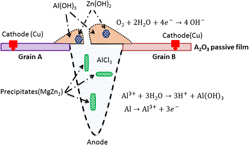Crossref Citations
This article has been cited by the following publications. This list is generated based on data provided by
Crossref.
Yang, Biaobiao
Shi, Chenying
Li, Yunping
Lei, Qian
and
Nie, Yan
2018.
Effect of Cu on the corrosion resistance and electrochemical response of a Ni–Co–Cr–Mo alloy in acidic chloride solution.
Journal of Materials Research,
Vol. 33,
Issue. 22,
p.
3801.
Xiao, Zhengbing
Hu, Jiawei
Liu, Yu
Dong, Fang
and
Huang, Yuanchun
2019.
Segregation of Sc and its effects on the strength of Al Σ5 (210) [100] symmetrical tilt grain boundary.
Materials Science and Engineering: A,
Vol. 756,
Issue. ,
p.
389.
Chen, Liang
Li, Yuqiang
Tang, Jianwei
Zhao, Guoqun
and
Zhang, Cunsheng
2019.
Investigation on microstructure and mechanical properties of Al–5.50Zn–2.35Mg–1.36Cu alloy fabricated by hot extrusion process.
Journal of Materials Research,
Vol. 34,
Issue. 18,
p.
3151.
Jeen Robert, R B
Hikku, G S
Jeyasubramanian, K
Jacobjose, J
and
Malkiya Rasalin Prince, R
2019.
ZnO nanoparticles impregnated polymer composite as superhydrophobic anti-corrosive coating for Aluminium-6061 alloy.
Materials Research Express,
Vol. 6,
Issue. 7,
p.
075705.
Azarniya, Abolfazl
Taheri, Ali Karimi
and
Taheri, Kourosh Karimi
2019.
Recent advances in ageing of 7xxx series aluminum alloys: A physical metallurgy perspective.
Journal of Alloys and Compounds,
Vol. 781,
Issue. ,
p.
945.
Lin, Y.C.
Wu, Qiao
He, Dao-Guang
Zhu, Xu-Hao
Liu, Dan-yang
and
Li, Xin-He
2020.
Effects of solution time and cooling rate on microstructures and mechanical properties of 2219 Al alloy for a larger spun thin-wall ellipsoidal head.
Journal of Materials Research and Technology,
Vol. 9,
Issue. 3,
p.
3566.
Sun, Shuangqing
Fang, Yi
Zhang, Le
Li, Chunling
and
Hu, Songqing
2020.
Effects of aging treatment and peripheral coarse grain on the exfoliation corrosion behaviour of 2024 aluminium alloy using SR-CT.
Journal of Materials Research and Technology,
Vol. 9,
Issue. 3,
p.
3219.
Sheng, Xiaofei
Yang, Yong
Cheng, Yajuan
Li, Jing
Wu, Wenke
Liu, Yu
Li, Kai
Zhao, Yifan
and
He, Guoai
2020.
Mechanism for enhancing the corrosion resistance in a spray deposition aluminum alloy Al-8.31Zn-2.46Cu-2.07Mg-0.12Zr.
Journal of Alloys and Compounds,
Vol. 845,
Issue. ,
p.
156198.
Wang, G.
Tuo, X.
Kou, L.
Zhao, W.
and
Zhu, X.
2020.
Research on corrosion performance of 6061 aluminum alloy in salt spray environment.
Materialwissenschaft und Werkstofftechnik,
Vol. 51,
Issue. 12,
p.
1686.
Chen, Y G
Yin, J C
Zhong, Y
Shao, G Y
Zhang, A M
and
Lu, W S
2020.
Direct continuous manufacturing Al–Zn–Mg–Cu alloy from a novel technology of spray-conform.
Engineering Research Express,
Vol. 2,
Issue. 1,
p.
015020.
Wang, Zhiping
Wang, Mingliang
Li, Yugang
Xiao, Hongyu
Chen, Han
Geng, Jiwei
Li, Xianfeng
Chen, Dong
and
Wang, Haowei
2021.
Effect of pretreatment on microstructural stability and mechanical property in a spray formed Al-Zn-Mg-Cu alloy.
Materials & Design,
Vol. 203,
Issue. ,
p.
109618.
Aqeel Talikoti, Mohammed
Kittur, M.I.
Raji Reddy, Avala
Ahmed Ali Baig, Maughal
Ridwan
Afghan Khan, Sher
and
Faheem, Mohammed
2021.
Influence of high and subsequent low-temperature artificial ageing on exfoliation corrosion of AA2024.
Materials Today: Proceedings,
Vol. 47,
Issue. ,
p.
6147.
Xiao, Song
Cao, Xiangkang
Dong, Zehua
Ma, Xiaoze
Zhang, Xinxin
and
Cai, Guangyi
2022.
A pH-responsive cerium-imidazole decorated ZIF-8 to achieve self-healing barrier property for epoxy coating on Al alloy by controlled release.
Progress in Organic Coatings,
Vol. 163,
Issue. ,
p.
106640.
Chanyathunyaroj, Kittisak
Moonrin, Nakarin
Laungsopapun, Ghit
and
Phetchcrai, Sompob
2022.
Corrosion Fatigue Study of 6061 Aluminum Alloy: The Effect of Coatings on the Fatigue Characteristics.
Metallurgical and Materials Transactions A,
Vol. 53,
Issue. 8,
p.
2874.
Wang, Zhiping
Xiao, Hongyu
Chen, Wei
Li, Yugang
Geng, Jiwei
Li, Xianfeng
Xia, Peikang
Wang, Mingliang
Chen, Dong
and
Wang, Haowei
2022.
New insight into precipitation of Al3Zr and correlative effect on recrystallization behavior in a rapidly-solidified Al-Zn-Mg-Cu-Zr alloy.
Materials Characterization,
Vol. 191,
Issue. ,
p.
112142.
Qiu, Yuxiao
Liu, Rongying
Zou, Linchi
Chi, Haitao
Wang, Chen
Wang, Binshu
and
Chen, Junfeng
2022.
Influence of Grain Boundary Precipitates on Intergranular Corrosion Behavior of 7050 Al Alloys.
Coatings,
Vol. 12,
Issue. 2,
p.
249.
Zobaer Shah, Quazi Md
Chowdhury, Mohammad Asaduzzaman
and
Kowser, Md Arefin
2022.
The aspect of the corrosion pitting with fretting fatigue on Aluminum Alloy: A nuclear reactor safety or an aerospace structural failure phenomenon.
Results in Engineering,
Vol. 15,
Issue. ,
p.
100483.
Chen, Huaguo
Chow, Cheuk Lun
and
Lau, Denvid
2022.
Deterioration Mechanisms and Advanced Inspection Technologies of Aluminum Windows.
Materials,
Vol. 15,
Issue. 1,
p.
354.
Olugbade, Temitope Olumide
Omiyale, Babatunde Olamide
Ojo, Oluwole Timothy
and
Adeyeri, Michael Kanisuru
2023.
Stress-Corrosion and Corrosion-Fatigue Properties of Surface-Treated Aluminium Alloys for Structural Applications.
Chemistry Africa,
Vol. 6,
Issue. 4,
p.
1699.
Xie, H.
Yang, Z.
Ma, Q.
Meng, W.
Hu, L.
and
Yin, X.
2023.
Effect of extrusion process on the stress corrosion cracking resistance of 7N01 aluminum alloy.
Journal of Mining and Metallurgy, Section B: Metallurgy,
Vol. 59,
Issue. 1,
p.
137.
